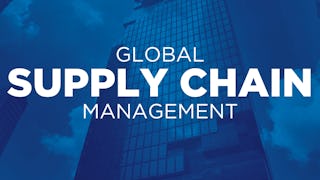In this course, you will learn about why and how supply chains become susceptible to a disruption. We will examine this by discussing supply side and demand side issues, primary supply chain flows, complexity, risk management and a combination of solid theoretical supply chain perspectives and current real-world stories. You will learn about the structural, relational and operational factors that come into play during a supply chain disruption and the mechanisms for the effective management of these factors. Your understanding will be enhanced through examples from manufacturing and health contexts, and the PPE supply chain disruption during COVID-19.



Managing Supply Chain Disruption During COVID-19

Instructor: Nehemiah Scott
9,573 already enrolled
Included with 
(139 reviews)
What you'll learn
Recognize the basic functions of a supply chain and key supply chain activities
Recognize the primary supply chain processes affected during a disruption and the primary causes of a disruption
Recognize various supply chain risk types and categories of disruption.
Understand key best practices for preparing for, responding to, and mitigating supply chain disruption.
Skills you'll gain
Details to know

Add to your LinkedIn profile
24 assignments
See how employees at top companies are mastering in-demand skills


Earn a career certificate
Add this credential to your LinkedIn profile, resume, or CV
Share it on social media and in your performance review

There are 4 modules in this course
In this module, you will be introduced to the concept and practice of supply chain management. Supply chain management from the past and current times will be compared to highlight its importance. The fundamental operation of the supply chain model will be explained using the SCOR Model, and the definition will be used to discuss roles, relationships, costs, logistics, and the supply chain “rights.” An example of how supplier performance can be measured will be given with a few examples of perfect order. The module ends with an explanation of matching products with a supply chain strategy based on Marshall Fisher’s well-known and Hau Lee’s supply chain strategy adaptation. A variety of examples are used.
What's included
9 videos6 readings6 assignments
In this module, you will be exploring the concept of supply chain disruption. Typical structural characteristics (e.g. complexity, lack of visibility, diamond shape, etc.) that make supply chains susceptible to disruption, will be identified and discussed. Risk, risk events, and risk management will be defined, the major disruption-related risk types will be described, and the importance of supply chain resilience will be explained. The module ends with a discussion about disruption probability and impact severity. Examples from manufacturing and health supply chains are used.
What's included
8 videos1 reading6 assignments
In this module, we will be applying the concepts learned from Module 1 and Module 2 to an actual supply chain disruption case. Specifically, this module explores several parts of the PPE supply chain that was disrupted during COVID-19. In addition, new concepts will also be introduced. For challenges in managing PPE demand, the bullwhip effect will be applied and ideas discussed. Fisher model and Lee’s adaptation will be revisited to discuss some of the strategic PPE challenges. The module ends with a discussion on issues and potential success factors of attempts to meet surge demand with surge capacity. Examples from the upstream and downstream health supply chain are used.
What's included
9 videos1 reading7 assignments
In this module, we will be discussing a variety of practices that can help organizations manage supply chain disruptions. An overarching set of practices will be explained first. In addition, practices for managing the bullwhip effect disruption will be given using the downstream health supply chain as an example. You will engage in three very simple simulated disruption events that will ultimately generate more specific best practices in supply chains. The module ends with a general discussion on managing the organization and caring for people. A variety of examples are used.
What's included
8 videos2 readings5 assignments1 peer review
Instructor

Offered by
Recommended if you're interested in Leadership and Management


Fundação Instituto de Administração


Technical University of Munich (TUM)


Macquarie University


Northeastern University
Why people choose Coursera for their career




Learner reviews
139 reviews
- 5 stars
81.29%
- 4 stars
14.38%
- 3 stars
1.43%
- 2 stars
0.71%
- 1 star
2.15%
Showing 3 of 139
Reviewed on Jan 10, 2021
Please bring a follow up course where we introduce Supply Chain Analytics.
Reviewed on Dec 2, 2020
Requesting for Masters in Supply Chain full Scholarship
Reviewed on Dec 6, 2020
I would like to thank you for this useful and new course on its topic
I especially thank Dr. Nehemiah Scott for his outstanding videos
New to Leadership and Management? Start here.

Open new doors with Coursera Plus
Unlimited access to 10,000+ world-class courses, hands-on projects, and job-ready certificate programs - all included in your subscription
Advance your career with an online degree
Earn a degree from world-class universities - 100% online
Join over 3,400 global companies that choose Coursera for Business
Upskill your employees to excel in the digital economy
Frequently asked questions
Once you enroll for a Certificate, you’ll have access to all videos, quizzes, and programming assignments (if applicable). If you choose to explore the course without purchasing, you may not be able to access certain assignments.
You will be eligible for a full refund until 2 weeks after your payment date. You cannot receive a refund once you’ve earned a Course Certificate, even if you complete the course within the 2-week refund period.
Yes! Coursera provides financial aid to learners who would like to complete a course but cannot afford the course fee. To apply for aid, select "Learn more and apply" in the Financial Aid section below the "Enroll" button. You'll be prompted to complete a simple application; no other paperwork is required.
More questions
Financial aid available,

